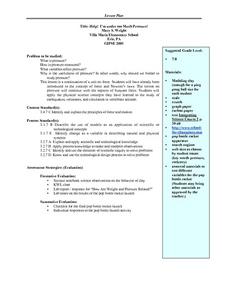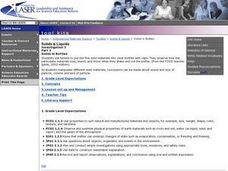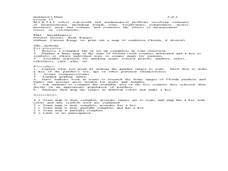Curated OER
Testing Foods
Learners perform an experiment using brown paper bags to determine which foods have oil in them. This task assesses student's abilities to make simple observations and inferences from them.
Curated OER
Mystery Boxes
Students make observations about Mystery Boxes that their teacher has made up and describes the motion of the object inside the box and hypothesizes it's shape based on their observations.
Curated OER
Color Dots 3
Students make simple observations, test mixtures, and make generalized inferences from their observations. They observe bleeding of colored inks with water.
Curated OER
Pendulum Patterns
Students identify the variables involved in the motion of a pendulum. In groups, they research how each different variable is related to the energy the pendulum produces. They share their results with the class and compare them with...
Curated OER
Ramps 1: Let it Roll!
Students perform the following activity as a group so that they can gain experience with how ramps work. Students will first construct a simple ramp and then time how fast different objects roll down that ramp.
Curated OER
Help! I'm Under Too Much Pressure!
Students play with a ping pong ball sized piece of modeling clay observing what happens to the clay as they play with it and write their observations in their notebooks. They share the results of their observations introducing the term...
Curated OER
Science: Liquid Matter
Second graders examine the properties of liquids and their classifications. They compare and contrast cups of different liquids and record their findings in journals. Students observe how liquids flow at various speeds and that unlike...
Curated OER
Fastest Glacier
Students compare and contrast continental ice sheets and a glacier. They discuss how glaciers form. Students research the average winter and summer temperatures for their area. They predict what might happen to the Greenland...
Curated OER
What are Quarters Made of?
Students study the meaning, symbolism, and value of U.S. coins,
especially the quarter. They l research why in 1965 the U.S. Mint decided to
change the metal composition of the quarter to copper coated with zinc. In addition, they...
Curated OER
Solids in Bottles
Students use funnels to put the five solid materials into clear bottles with caps. They observe how the particulate materials look, sound, and move when they shake and roll the bottle. Finally, students write "sound and touch" poetry.
Curated OER
Fishing Line Tests
Students test the strength of fishing lines. In this stress test lesson, students will investigate the breaking point of various fishing lines and graph the results.
Curated OER
Water and Ice
Students explore the states of water. In this water states lesson plan, students observe ice over time and the changes that take place. Students read a related text and draw their observations in a journal entry. Students discuss the...
Curated OER
ROLLER COASTERS IN THE CLASSROOM
Students define potential and kinetic energy and explain the relationship of height to potential energy. In this roller coaster lesson students construct a model of a roller coaster which will allow them to see the basic physical laws.
Curated OER
Home on the Range
Students use maps and mathematics to determine the appropriate panther population in a given area. In this Florida ecology lesson, students research the area requirements of male and female panther and use a map to help calculate how...
Curated OER
You say Avocado, I say Avogadro
Students convert mole to mass to particles and vice versa. In this chemistry instructional activity, students discuss the importance of Avogadro's number. They apply what they have learned in a team competition.
















